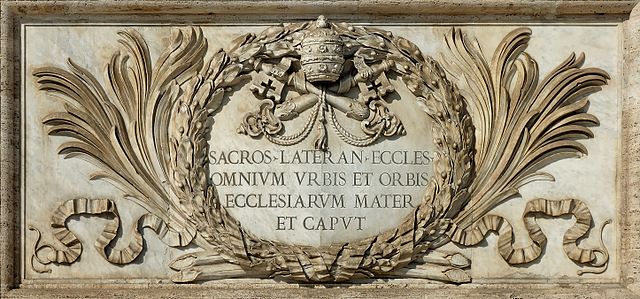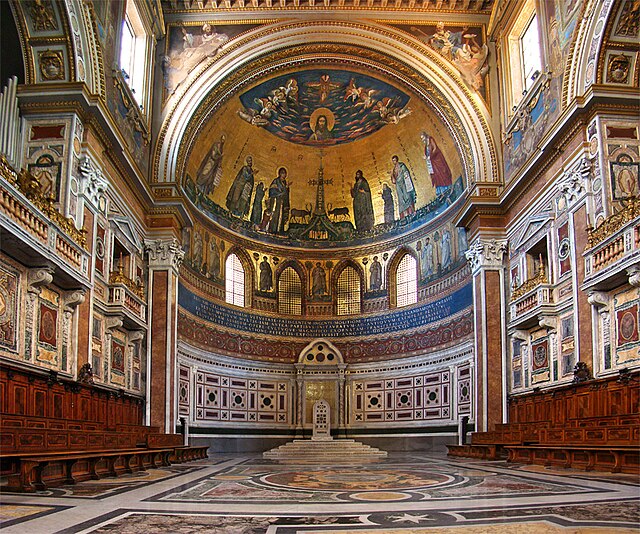Archbasilica of Saint John Lateran
The Archbasilica of Saint John Lateran is the Catholic cathedral of the Diocese of Rome in the city of Rome, and serves as the seat of the bishop of Rome, the pope. The archbasilica lies outside of Vatican City proper, which is located approximately four kilometres northwest. Nevertheless, as properties of the Holy See, the archbasilica and its adjoining edifices enjoy an extraterritorial status from Italy, pursuant to the terms of the Lateran Treaty of 1929. Dedicated to the Christ, in honor of John the Baptist and John the Evangelist, the place name, Laterano (Lateran) comes from an ancient Roman family (gens), whose palace (domus) grounds occupied the site; the adjacent Lateran Palace was the primary residence of the pope until the Middle Ages.
Façade of the Archbasilica of the Most Holy Savior at the Lateran
Next to the formal entrance is the archbasilica's declaration to be the head, or Mother Church, of the entire world. Note the laurel wreath and the Papal tiara.
The papal cathedra, the presence of which renders the archbasilica the cathedral of Rome, is located in its apse. The decorations are in cosmatesque style.
The high altar and the 14th-century Gothic ciborium. The relic of the original wooden altar used by Saint Peter comprises the high altar. Above the ciborium are statues of Sts. Peter and Paul.
A cathedral is a church that contains the cathedra of a bishop, thus serving as the central church of a diocese, conference, or episcopate. Churches with the function of "cathedral" are usually specific to those Christian denominations with an episcopal hierarchy, such as the Catholic, Eastern Orthodox, Anglican, and some Lutheran churches. Church buildings embodying the functions of a cathedral first appeared in Italy, Gaul, Spain, and North Africa in the 4th century, but cathedrals did not become universal within the Western Catholic Church until the 12th century, by which time they had developed architectural forms, institutional structures, and legal identities distinct from parish churches, monastic churches, and episcopal residences. The cathedral is more important in the hierarchy than the church because it is from the cathedral that the bishop governs the area under his or her administrative authority.

São Paulo Cathedral in Brazil is a representative modern cathedral built in Neo-Gothic style.
The cathedra of the Pope as Bishop of Rome, Archbasilica of Saint John Lateran
Etchmiadzin cathedral in Vagarshapat, Armenia, believed to be the oldest cathedral in the world.
The Cathedral of Santa Maria Assunta is a Catholic cathedral in Nepi, Italy







